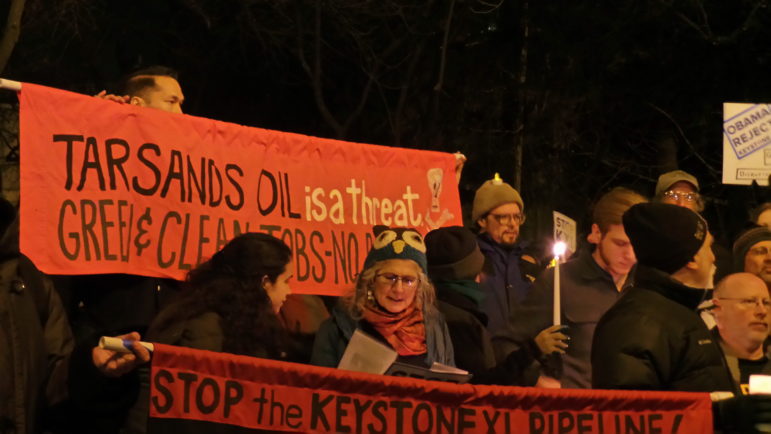
Brylie Oxley
Protesters against the Keystone Pipeline, which looked liked environmental madness to some and a job-creation machine to others.
The head of the 500,000 member laborers’ union recently reacted angrily to the national AFL-CIO after AFSCME and teacher unions joined with wealthy climate change activist Tom Steyer to launch a $50 million get out the vote effort for the fall elections.
The New York Times described it as further evidence of the declining political clout of organized labor as the number of union members drop, especially in the traditional construction and blue-collar jobs. Many of these older, white union members tend to support more conservative candidates, often outside the Democratic Party. And they are not predisposed to support environmental causes.
But the relationship between labor groups and climate activism is more nuanced than the headline-generating feud would indicate. Much of it revolves around the question of whether the green economy will provide the same kind of job opportunities as the fossil-fuel powered one has.
For decades environmentalists have hammered home the message that investing in a healthy environment is not in conflict with good jobs. In fact, transitioning to 100 percent renewable energy is also the path to full employment, with the potential to create tens of millions of decent paying jobs. Activists had argued that one way to avoid economic collapse in both Greece and Puerto Rico was a massive investment in wind and solar power to put people to work and stimulate the economy.

No Backspace is City Limits' new blog featuring a recurring cast of opinion writers passionate about New York people, policies and politics. Click here to read more..
The number of jobs in U.S. solar energy overtook those in oil and natural gas extraction for the first time last year. Solar jobs nationally grew 12 times faster than overall job creation, according to the International Renewable Energy Agency. More than eight million people worldwide had clean energy jobs in 2015. It is estimated that investments in renewable energy produces 3 times as many jobs as a similar investment in fossil fuels or nukes.
Yet unions representing workers in the fossil fuel industry haven’t yet climbed aboard the climate action bandwagon. Activists try to address their concerns by advocating for a Just Transition to protect local workers and governments dependent on the fossil fuel economy. But for many a job in hand is worth two in the bush. Workers with an existing hefty paycheck are skeptical that the new jobs in renewable energy will pay as much and suspect that they would be forced to leave their existing community to find new employment.
The successful fight against the Keystone XL pipeline pitted unions against each other. The Laborers International Union of North America (LIUNA) and the United Association of Plumbers & Pipefitters (UA) supported the pipeline because they believed it would create thousands of high-wage jobs for their members. When the CWA, SEIU, UAW, Transport Workers Union, United Steelworkers Union and Amalgamated Transit Union joined the Sierra Club in announcing their opposition, the Laborers denounced them as job killers and rescinded their membership in the Blue-Green Alliance.
City Limit’s recent report on the Green Jobs/Green New York program underscores the problem of credibility in green-job creation promises. In 2009 state officials said the program would retrofit a million houses while creating 14,000 jobs. The results so far have fallen well short, at least partially because of roadblocks thrown up by the governor’s office, banks and utility companies to providing financing to low-income consumers. Unions went out on the limb for the program and now are skeptical about supporting future efforts. Many feel that advocates need to push through reforms to enable the program to function as hoped.
However, the face of the union movement is changing. Membership in the blue-collar private sector unions have steeply declined. The growth in union membership has been in the public sector, many of whose members are concerned about the negative health and environmental impacts from climate change and fossil fuels. They worry about the quality of life they will leaving for their children and grandchildren if global warming is not curbed. There are an estimated 3,000 “excess” death in NYS annually from breathing fossil fuel air pollution. Public employee unions, starting with health care workers, were a large contingent in the 400,000 strong People’s Climate March in NYC in September 2014. The NYS Nurses Association has been among the most active unions working on climate change due to the many health problems associated with burning fossil fuels. They were a visible presence at the recent 1,500 strong Break Free from Fossil Fuel protest targeting oil bomb trains at the Port of Albany.
Recent climate change coalition efforts in New York bringing together unions, low-income community groups and environmental justice advocates have largely focused on the job creation aspects of renewable energy while avoiding taking positions opposing fossil fuel construction projects such as natural gas pipelines. The agenda of such coalitions have often been less about reducing climate change than about climate resiliency and responding to climate damage, ensuring that a fair percentage of new jobs created in response go to residents from the impacted communities.
Much of the real grassroots climate change activism and passion is from community residents worried about the damage that they will suffer from such fossil fuel infrastructure projects. They find themselves excluded from leadership roles in the coalitions that seek broad union participation.
Yet even as some labor unions support fossil fuel projects, they are working at the local level to expand the green economy. LIUNA has created OptiHome, an alliance of skilled workers and certified contractors working in the energy efficiency sector. UA created the nation’s first union “sustainability office” in the country, which is developing three new “green” craft-specific certifications
Like other powerful institutions, organized labor faces serious challenges in maintaining its relevancy in a rapidly changing world. The Fight for $15 has injected a much needed sense of class solidarity into the labor movement. A similar effort is underway with respect to climate justice but it will have its share of bumps along the way
Deliver real jobs, and more unions will advocate for a clean energy transition.









One thought on “No BackSpace: Why Climate Change Divides the Labor Movement”
This comment comes from an email correspondent:
The Great Climate Change Bamboozle
“The whole aim of practical politics is to keep the populace alarmed (and hence clamorous to be led to safety) by menacing it with an endless series of hobgoblins, all of them imaginary.”
H. L. Mencken
Earth’s carbon cycle contains 46,713 Gt (E15 gr) +/- 850 GT of stores and reservoirs with a couple hundred fluxes Gt/y +/- ?? ebbing and flowing between those reservoirs. Mankind’s gross contribution over 260 years was 555 Gt or 1.2%. (IPCC AR5 Fig 6.1) Mankind’s net contribution, 240 Gt or 0.53%, (dry labbed by IPCC to make the numbers work) to this bubbling, churning caldron of carbon/carbon dioxide is 4 Gt/y +/- 96%. (IPCC AR5 Table 6.1) Seems relatively trivial to me. IPCC et. al. says natural variations can’t explain the increase in CO2. With these tiny percentages and high levels of uncertainty how would anybody even know?
Mankind’s alleged atmospheric CO2 power flux (watt is power, energy over time) increase between 1750 and 2011, 260 years, was 2 W/m^2 of radiative forcing. (IPCC AR5 Fig SPM.5) Incoming solar RF is 340 W/m^2, albedo RF reflects 100 W/m^2 +/- 30 (can’t be part of the 333), 160 W/m^2 reaches the surface (can’t be part of the 333), latent heat RF from the water cycle’s evaporation is 88 W/m2 +/- 8. Mankind’s 2 W/m^2 contribution is obviously trivial, lost in the natural fluctuations.
One popular GHE theory power flux balance (“Atmospheric Moisture…. Trenberth et. al. 2011 Figure 10) has a spontaneous perpetual loop (333 W/m^2) flowing from cold to hot violating three fundamental thermodynamic laws. (1. Spontaneous energy out of nowhere, 2. perpetual loop w/o work, 3. cold to hot w/o work, 4. doesn’t matter because what’s in the system stays in the system) Physics must be optional for “climate” science. What really counts is the net RF balance at ToA which 7 out of 8 re-analyses considered by the above cited paper concluded the atmosphere was cooling, not warming, +/- 12.3 W/m^2. Of course Trenberth says they are all wrong because their cooling results are not confirmed by his predicted warming, which hasn’t happened for twenty years.
Every year the pause/hiatus/lull/stasis continues (IPCC AR5 Box TS.3) IPCC’s atmospheric and ocean general circulation models diverge further from reality.
As Carl Sagan observed, we have been bamboozled, hustled, conned by those wishing to steal our money and rob us of our liberties. Hardly a new agenda.
BTW I have a BSME same as Bill Nye so I’m as much a scientist as he is.
http://2paragraphs.com/2015/07/ivar-giaever-nobel-climate-change-denier-galileo-or-ptolemy/
http://joannenova.com.au/global-warming/